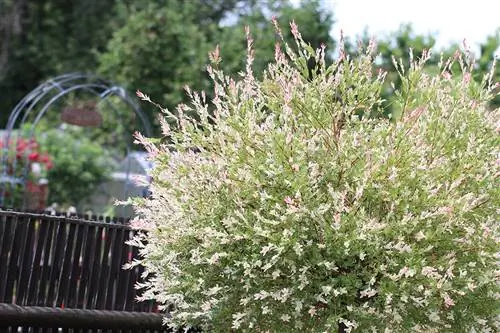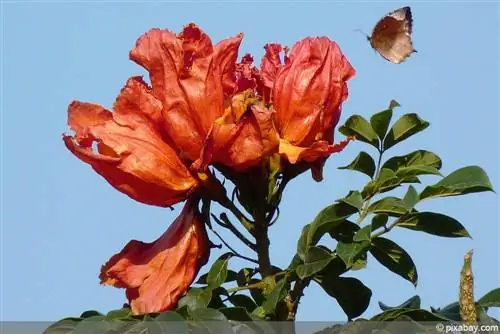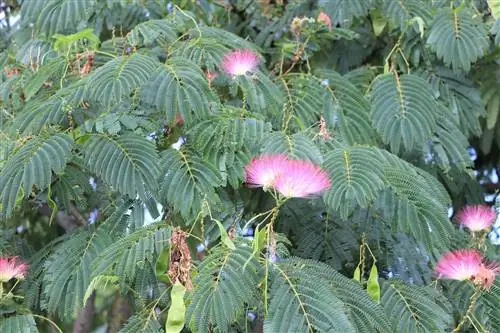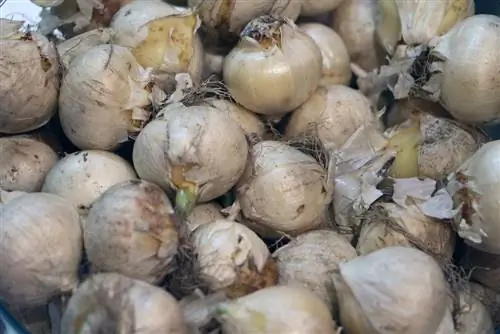- Author admin [email protected].
- Public 2023-12-17 03:39.
- Last modified 2025-01-24 12:45.
With a furious triad of flowers, decorative leaves and autumn colors, the tulip tree deserves a front seat in the garden. The beautiful tulip-shaped flowers cannot deny their close relationship to magnolia. Apart from that, the ornamental tree presents itself with majestic growth and has specific requirements. Familiarize yourself with all the details of professional cultivation here. In this guide you will learn everything about caring for and cutting a Liriodendron tulipifera.
Location
The choice of location is a key function in successful cultivation. A look at the home of the tulip tree makes it clear which criteria are important. The main distribution area extends over the east and southeast of North America with the mountain ranges of the Appalachians. In the north its habitat extends to Rhode Island. To the south, the border of his home region is at the northern border of Florida.
Therefore, a Liriodendron tulipifera is used to climatic conditions similar to those that prevail in Central Europe. However, summers are noticeably hotter and have more precipitation. In winter the climate is milder. In addition, the tulip tree thrives as a shallow-rooted tree, which makes it susceptible to windthrow. Therefore, choose a location with these characteristics:
- Sunny to semi-shady location with at least 4 hours of sunshine in summer
- Warm and protected from the wind
- Nutritious, fresh to moist soil
- Preferably sandy-loamy and well-drained
- Neutral to slightly acidic pH is an advantage
- In the large pot, a structurally stable, peat-free potting soil
A tulip tree reacts to compacted soil with stunted growth. Therefore, please avoid proximity to paths, seats and paved areas. Although its impressive dimensions require a solitary placement, the location should still be embedded in the protection of hedges, bushes or trees.
Tip:
Do not confuse a North American tulip tree with the South African tulip tree (Spathodea campanulata), as they are not botanically related and are native to different parts of the world. While the Liriodendron tulipifera is winter hardy down to -20 degrees Celsius in its advanced age, its African namesake shudders at temperatures below 15 degrees Celsius.
Watering in summer
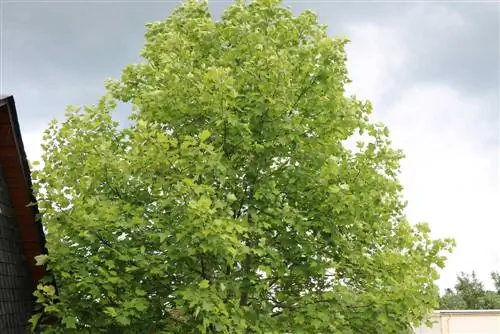
As the short excursion into the general conditions of its North American habitat shows, the tulip tree is nourished by extensive rainfall in summer. For this reason, evolution saw no reason to equip the ornamental tree with a deep root system. In summer heat and drought in the Central European climate, the plant is threatened by drought stress. How to properly water the tulip tree in summer:
- Do not let the soil dry out at any time
- If the surface feels dry, watering is required
- Water thoroughly in summer when there is no rain
- Run the water hose for 60 minutes two to three times a week
In the pot, the root ball dries out more quickly than in the bed due to its exposed position. Please check the condition of the plant soil daily using a finger test. Press your thumb one to two centimeters deep into the substrate. Don't feel any moisture here, keep watering until the saucer fills up. In midsummer this may be necessary early in the morning and again in the evening. It is important to note that you do not overwater the tulip tree because damp leaves increase the susceptibility to fungal infections.
Fertilizing in summer
With a growth rate of up to 70 cm per year, a tulip tree uses a lot of energy for this reason alone. To ensure that a dense flower and leaf complex develops, support the tree's floral arms with a regular supply of nutrients. How to fertilize a Liriodendron tulipifera with expertise:
- In the bed: April to August, add mature leaf compost with horn meal every 4 weeks
- Rake 3 to 5 liters of compost with 100 grams of horn meal onto the surface per square meter and pour in again
- Alternatively, use a mineral-organic long-term fertilizer in April, June and August
- In the bucket: April to August add a liquid fertilizer to the irrigation water every week
With a fertilizer that emphasizes potassium, you can strengthen winter hardiness in late summer. Therefore, in August, switch the nutrient supply to potassium-rich comfrey manure or add a potassium fertilizer such as Patentkali. Please stop applying fertilizer at the beginning of September at the latest so that the branches can mature before winter. Fresh, unwoody shoots in autumn weaken winter hardiness and make the tulip tree susceptible to frost damage.
Tip:
Choose the location for a tulip tree carefully. The sensitive magnolia plant is one of the trees that do not like to be transplanted, even when young. Therefore, initial cultivation in a pot with later planting is also not advisable.
Care in winter
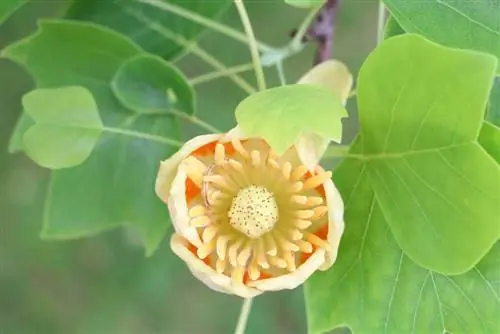
A tulip tree sheds its leaves in late autumn, which significantly increases the conditions for an undamaged overwintering. Nevertheless, the ornamental tree has to develop its robust frost tolerance of up to -20 degrees Celsius over the years. Care in winter is primarily aimed at protecting a Liriodendron tulipifera from severe frost and winter drought stress.
- In the first 5 years: Cover the tree disc with leaves and needles, cover the crowns with fleece
- In subsequent years: Wrap trunks with jute ribbons or fleece to protect them from winter sun
- Alternatively, lean wooden boards against the trunk or surround the bark with reed mats
- Watering the tulip tree when there is frost on mild days
- Do not fertilize from September to March
Please place the bucket on an insulating wooden block. If the heavy container is on a plant roller, pad the cavity above the ground with leaves or straw. Wrap the container with a winter coat made of fleece or virgin wool and an additional coconut mat that extends 10 cm beyond the edge of the container. Cover the substrate with a thick layer of leaves, straw or wood shavings. As soon as the temperatures in spring permanently exceed freezing point, remove the winter protection in the bed and pot alike. Only the sensitive trunk bark should be protected from the strong sun until April to avoid cracks.
Cutting
A tulip tree develops its picturesque silhouette with a columnar to conical, later spreading crown without any gardening intervention with scissors and saws. Pruning is only part of the care program in exceptional cases. If the tree grows too large, its crown becomes bare or too powerful, you can remedy the shortcoming. The best time for a shape and maintenance cut is during the leafless period between November/December and March/April. Occasional corrections can be made in summer, immediately after the end of the flowering period. How to cut the tulip tree correctly:
- Cut back frozen branches to he althy wood
- Thin out dead branches on Astring
- Short shoots that are too long to the desired length
- Remove branches that point towards the inside of the crown or cut back to an outward-facing eye
To remove a single, thick branch from the crown, an overcast, dry day in summer is ideal. This has the advantage that the cut heals more quickly in the middle of the growing season. Proper incision requires a step-by-step procedure. First saw the branch from below at a distance of 20 cm from the trunk. Then position the saw slightly offset from above and saw until the branch breaks off. Only then do you cut off the stub on Astring. The thickening between the branch and the trunk is called an astring. This bead must not be damaged. Nevertheless, no residue in the form of a coat hook should be left, because pathogenic pathogens have an easy time of it here.
Clean up wilted flowers or not?
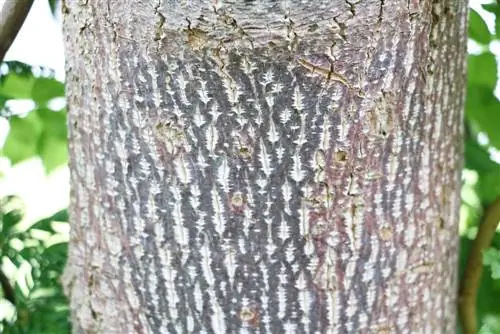
The large flower cups, up to 10 cm in size, transform into impressive fruits with a primitive shape by autumn. These are vaguely reminiscent of conifer cones. This is hardly surprising, because as a magnolia plant, the tulip tree belongs to the class of angiosperms. In order not to deprive yourself of the autumn fruit decorations, simply leave the withered flowers standing. Apart from that, it would probably be a complex undertaking to remove withered flowers from a meter-high crown in order to prevent self-sowing.
Tip:
Is your garden not spacious enough for a tulip tree up to 35 meters high and 20 meters wide. Then cultivating the cultivar Liriodendron tulipifera 'Fastigiatum' is a good idea. The columnar tulip tree limits its height to 15 to 18 meters and is up to a maximum of 6 meters wide.
Common care mistakes
If a tulip tree sheds its leaves, the foliage turns yellow in the middle of summer or the flower fails to bloom, the dilemma usually results from neglect in care. We have summarized the most common causes for you below with tips for solving the problem:
- Drought stress causes leaf drop: Water regularly and abundantly at any time of year without causing waterlogging
- Hard water causes the leaves to yellow: water primarily with rainwater or soft tap water
- Lack of nutrients causes sparse flowers: fertilize organically with acidic leaf compost from spring to autumn
- Potassium deficiency affects winter hardiness: fertilize in August with potash or comfrey manure
- Defrosting s alts damage the roots: Do not apply road s alt in the immediate vicinity of the tulip tree
In the majority of cases, excessive tillage is responsible for problems on the tulip tree. The shallow root system is very sensitive to disturbance and injury from the garden rake or spade. Please only apply organic fertilizer to the surface and pull out weeds with your hands.
Diseases and pests
A tulip tree is usually spared from diseases. The same applies to pest infestations. Since the ornamental tree came to our gardens and parks from distant regions, no insects have yet specialized on its leaves, flowers and shoots. The only exception are the omnipresent aphids, which like to feast on fresh growth. Sticky leaves are a common symptom of lice infestation because they excrete honeydew as a waste product. If you can easily reach the crown, fight the pests with a solution of 1 liter of water and 20-40 grams of liquid soap.
Otherwise, tits and ladybirds keep the pests under control. You can effectively prevent initial colonization by equipping the trunk with glue rings. Use the sticky barrier to stop ants from carrying aphids into the crown. Clever ants use this strategy to get the coveted honeydew.


